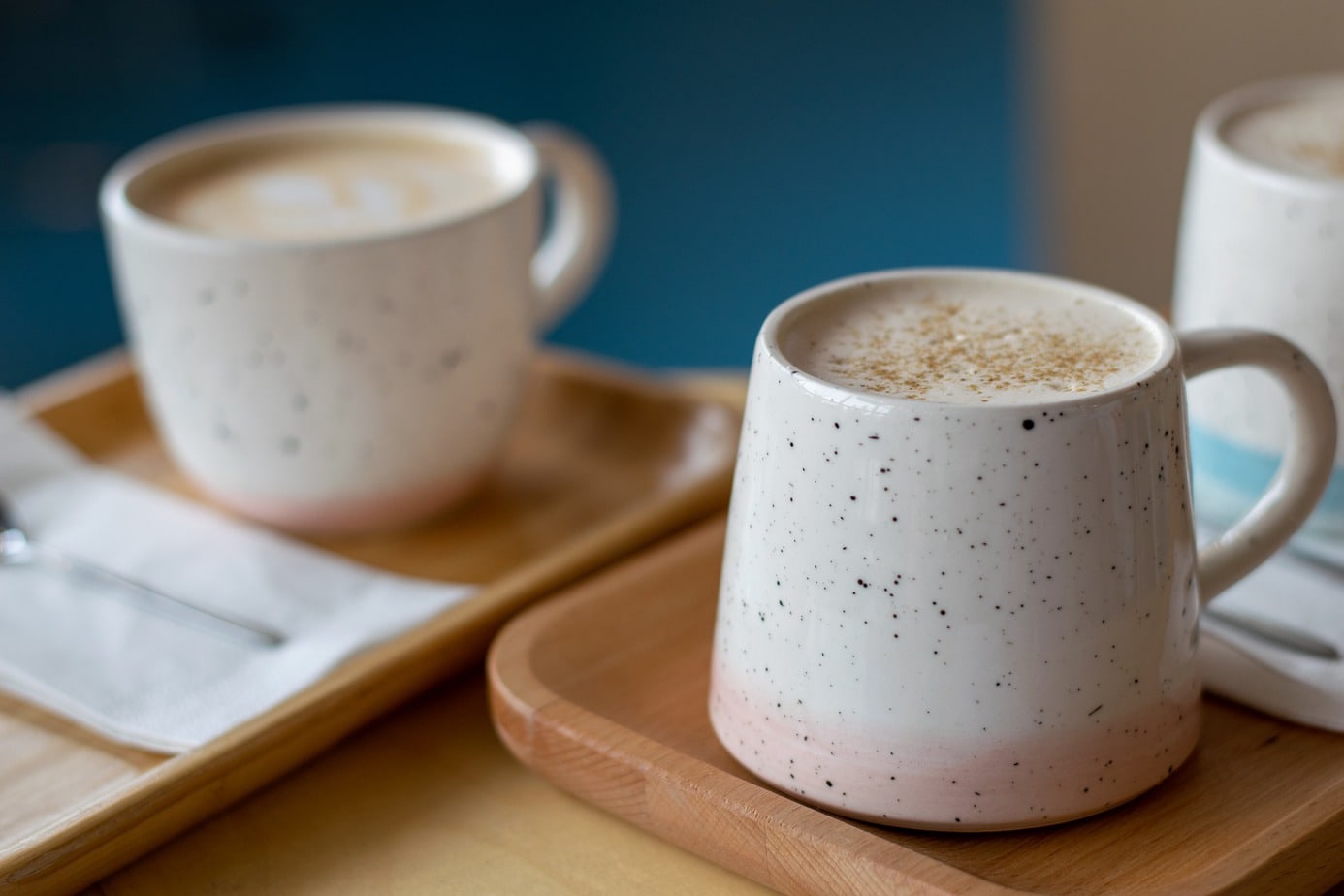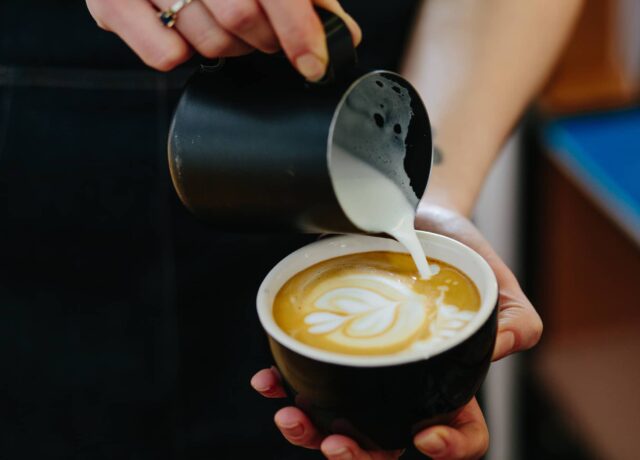How many drinks can you make by mixing steamed milk, foam, and espresso? It turns out the answer is more than you’d think. There are flat whites, macchiatos, cortados, and more, but today, we’re comparing two that on the surface seem nearly identical: the cappuccino and the latte.
Okay, we know any expert-level coffee fiend would gasp at the idea of someone saying these two drinks are the same thing, for the average Joe, they can be hard to differentiate. So, kudos to you for trying to navigate the sometimes confusing world of espresso drinks. Don’t worry though, we’re going to help you out. To assist in your endeavor to pick a team, we’ve put together this easy comparison, so you can know what you’re ordering next time you’re at the local coffee shop.
Oh, and just so you know, for those who’ve got it figured out, there’s a pretty harsh split between those who are team cappuccino and those who are team latte, so after you’ve got all the information, choose your team carefully.

First, the Ingredients
…are exactly the same. And actually, there are a few other coffee drinks that are made from the very same things, too.
But don’t start pulling your hair out just yet! Yes, these two Italian delicacies join the ranks of the other types of coffee drinks that are made by mixing espresso, steamed milk, and foam. But we promise there are key differences between the two but don’t worry, we’ll cover those later.
Because the ingredients are pretty easy to find, you can make either of these delicious espresso-based beverages at home with a little practice and an espresso machine (or a little ingenuity if you don’t own one of the high-pressure brewers).
And here’s a note for our at-home baristas: both of the drinks we’re talking about are pretty versatile and pair well with various added flavors.
Other Coffee Drinks Made with Espresso and Milk:
- Flat white: Though often confused for a latte, the flat white differs from the aforementioned drink because of its milk-to-espresso ratio. While they both contain one to two shots of espresso, a good barista will be sure the flat white is less bubbly and more fluffy and glossy-looking.
- Espresso Macchiato: An espresso macchiato is usually served in an espresso glass or demitasse cup and only contains a couple of teaspoons of steamed milk. It’s topped with a light layer of foam.
- Latte Macchiato: Since it’s a layered drink and usually served in a 12-ounce glass or cup, the latte macchiato is quite similar to the latte. The biggest difference, though, is that in this instance, the shot of espresso lies between the layers of steamed milk and foam instead of underneath them.
- Cortado: Despite boasting the same ingredients as the stars of our show — the cappuccino and latte — you’ll know this spunky coffee drink as soon as you see it for two reasons. The first reason is that it usually doesn’t have a layer of milk foam on top, and number two being the fact that it’ll likely be served in a small Gibraltar glass rather than your typical ceramic mug or demitasse cup.
What makes them different from regular coffee?
There are several differences between espresso and regular coffee, including the beans’ method of preparation and taste.
When it comes to preparing the coffee, beans used for espresso are usually roasted longer and darker than those intended for brewing drip coffee, which ultimately affects the taste of the final brew. Espresso beans also need to be ground more finely before they’re brewed so they can survive the high pressure and temperatures of an espresso machine.
Cappuccino vs. Latte: The Fundamentals
Before we get into the difference between lattes and cappuccinos, it’s important you know what each of the popular coffee drinks is.
Cappuccino
The cappuccino was born alongside the original hype of espresso and evolved into the drink we know today during the World Wars, ultimately arriving in Europe and the Americas around 1980.
Now, they are very structure-oriented drinks, usually served in squatty, six-ounce glass or ceramic cups. That structure is truly their defining feature. Split evenly into thirds, you can almost feel the quality of a cappuccino by its weight. Ideally, there should be a 1:1:1 ratio of coffee, milk, and foam, with the espresso layered underneath the hot milk and airy foam.
For this reason, cappuccinos are often considered the true test of a barista’s skills. If the barista is worth his or her stuff, your drink will have low acidity and a delightfully rich and airy feel.
How does the traditional cappuccino made in Italy differ from the one served in the United States?
Perhaps the most significant difference lies in the size of the beverage. Some coffee shops give coffee lovers small, medium, and large (or tall, grande, and venti, if you’re at Starbucks) options for their cappuccinos, but in Italy, that isn’t the case. The cappuccino you would find in Italian coffee shops is usually six ounces.
Latte/Café Latte
Though the English term was first used in 1867, variations of the latte have been a breakfast staple for centuries. It originated from the Italian phrase denoting milk coffee. However, this drink’s presence in cafes is a distinctly 20th-century development.
Lattes are served in the larger eight-ounce cup as compared to the smaller cappuccino cups, and to achieve its creamier, velvet-like texture, mix one perfect espresso shot (or two when you need something a little stronger) with five to six ounces of steamed milk. That mixture takes up about five-sixths of the cup, and a thin layer of foam should sit on top of the classic espresso drink.
While cappuccinos have their beautiful structure as a defining element, lattes often have equally impressive foam art on top. So if you’re at the coffee shop for a photo-op, order a latte.
Ratio of Espresso to Milk
As you may have guessed by our breakdown, the main difference in these drinks is the ratio of the ingredients.
With these, the barista must achieve a perfect and harmonious balance of milk to espresso.
Both drinks have one to two shots of espresso (the second shot is more common in America because they generally use larger cups). However, a latte will have more steamed milk, which is mixed into the espresso. A cappuccino, on the other hand, will have more foam and less milk, and the milk is not mixed, giving you defined layers.
For this reason, a cappuccino is going to have a significantly stronger taste of espresso, both because it’s less mixed and less diluted by the steamed milk overall. It’s also going to be crisper due to the defined layers and lighter foam.
On the other hand, a latte will be much creamier thanks to the denser foam and the increased portion of steamed milk. Thus, you’ll end up with a milder coffee taste.
The Barista Factor
To really understand the difference between these two drinks, your barista (or you if you’re making the espresso-based coffee drink at home) must know what they’re doing. Unfortunately, in a lot of high-volume coffee shops, the preparation of these drinks can be wildly inconsistent, making them even more difficult to differentiate.
One issue that may come up is if the milk is frothed the same for both drinks. Ideally, the foam for a cappuccino is going to be more light and airy than the denser, creamier foam of a latte. If you find you aren’t getting that airy texture, ask your barista to make your cappuccino more “dry.”
In coffee speak, that translates to fluffing and stretching the milk a little more when frothing to get it closer to that classic cappuccino texture.
People Also Ask…
Which has more caffeine, a latte or a cappuccino?
Good question! Because both a latte and a cappuccino are made with a single shot of espresso, they boast the same caffeine content.
What is better for you, latte or cappuccino?
Determining which type of coffee drink is healthier pretty much depends on how you make it. If you use whole milk, for example, a latte is going to have a higher calorie and fat count since it’s made with more milk than a cappuccino.
If you’re concerned about health, try using a milk substitute, like almond or oat milk. Make sure you do your research, though, so you find something that best meets your nutritional needs.
And that leads us right to the next question:
Can the type of milk affect the flavor of either coffee drink?
Yes! Not only does the milk content of coffee drinks alter their taste, but the type of milk does, too.
Whole milk, for example, leaves your coffee beverage rich, creamy, and sometimes a little sweet. Almond milk, on the other hand, has a lighter body and a distinctly nutty flavor that some coffee drinkers love while others aren’t too fond of.
If you’re planning on enjoying a cup of coffee with a non-dairy milk substitute added to it, you may need to do a little research and a bit of taste-testing to figure out what will make the perfect cappuccino or latte for you.
Which one would I like the most?
Well, Roasty reader, we can’t fully answer that question for you since it’s a matter of personal preference. But we can tell you that, even though both drinks are made with a single espresso shot, the cappuccino is a stronger drink since it contains less milk.
Keeping that in mind, we’ll say the cappuccino is better for someone who wants to taste more of the coffee’s natural flavors and the latte is for coffee drinkers who want something more mellow.
Go and Express-o Yourself
Both of these beverages are classic and delicious. So try both and get a feel for which texture and espresso strength fits your tastes.
And no matter which of these drinks you choose…Happy Caffeinating!







